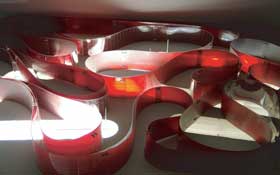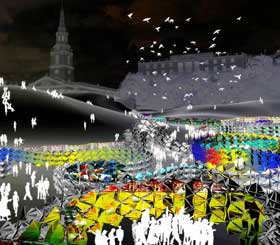Base_4 (Bidisha Sinha, Andres Flores, Simone Contasta and Elena Bertarelli) have published their project for an interactive space for the London Olympics in 2012.
The various sporting venues dispersed in the city would be broadcasted within the looped venue of the Loop.space Olympic pavilion, enabling different types of crowd to enjoy several sporting events at the same time. Inside the pavilion, each looped space is perceived as an immersive environment in which the relationship of scale and proportion between the viewer and projection are modified.
 A prototype in scale 1:50 shows the deformation of the structure and the relationship of the pavilion to the feedback mechanism
A prototype in scale 1:50 shows the deformation of the structure and the relationship of the pavilion to the feedback mechanism
The pavilion can unfold itself as needed into a network of spaces which are defined by parameters of time, boundary, crowd density and program; the structure is able to continuously adapt itself to any kind of boundary condition.
 View of the pavilion in Trafalgar Square, allowing groups to congregate in different loops according to their sporting interests
View of the pavilion in Trafalgar Square, allowing groups to congregate in different loops according to their sporting interests
There are 3 structural deformations: tilting (vertical deformation), loop formation (horizontal curvature) and twisting (diagonal deformation), and each space can perform them singularly or in combination to achieve the spatial quality requested by the programme and the user.
Multifaceted polygons mounted on a spline form the pixilated wall capable of transmitting the data stream. Over each polygon either 5mm or 15mm LEDs are installed (similar to the Smartslab system), allowing a perfect viewing resolution from both close and distant proximity. The locomotion of the structure is an integral part of it, with embedded direct drive wheels within the lowest row of the pixel polygons.
The project won the Biennal Miami + Beach Possible Futures Competition 2005.
Via resarch.
